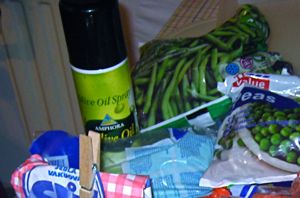 Here's some fat to chew over the weekend: Do you really need to take a recipe's instructions to use "1 tablespoon oil" for stovetop cooking literally?
Here's some fat to chew over the weekend: Do you really need to take a recipe's instructions to use "1 tablespoon oil" for stovetop cooking literally?Watch television cooking shows for any amount of time and you'll notice that the chefs never measure anything. Some, like Rachael Ray, even take the time to teach you that measuring slows you down in the kitchen.
What's this tell us? That standard one tablespoon of oil thrown in the pan before your meats and veggies is nothing but a recipe writer's fudge. In fact, not every recipe needs nearly so much oil to succeed.
Chefs add oil to the pan to promote browning, even cooking, and flavor. It also keeps food from sticking to stainless-steel pans; for that reason, use these techniques only with nonstick or seasoned cast-iron pans. Otherwise, when deciding your approach to oil, consider what your food needs:
Fighting the stick factor. If you're only worried about your eggs or fish cementing themselves to your skillet, switch to a quick spritz of nonstick spray or aerosolized oil. Alternatively, moisten a paper towel with a little oil and rub it all over the pan bottom.
Even cooking and flavor. I usually slash the tablespoon of oil down to a mere teaspoon when I sauté. That's enough help the pieces soften evenly without burning in spots, and even a little fat adds plenty of flavor to a finished dish.
Even browning for large items. Vary your pour based on what you're cooking. I find one teaspoon is enough for one cutlet. Basically, you need enough to cover the meat with a thin coat. Pour each teaspoon directly into the pan or rub it on the cutlet directly as you prep.
Frying. Counterintuitively, the more oil you use to fry, the less your food will take in. Fill a deep pan with a few inches of oil and heat it to temperature (use a deep-fat thermometer) before adding any food. Ample oil ensures that the fat will return to the correct temperature quickly after the food is added, minimizing the cooking time and the amount of oil the food will absorb as it cooks. Still, avoid frying frequently as it's hard to tell how much oil you'll be consuming.
By the way, the chefs are right: Measuring will slow you down. Use the teaspoon measure the first few times you cook with less oil, and you'll soon learn to eyeball it as well as you might now eyeball a tablespoon.
Technorati Tags:
diet, dieting, food, health, healthy eating, nutrition, weight loss




No comments:
Post a Comment